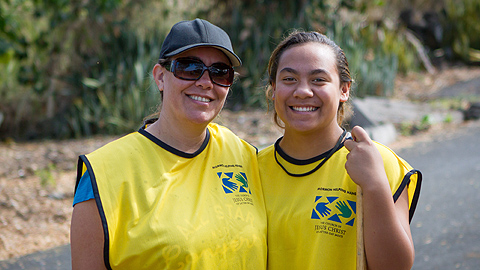Overview
The yellow Mormon Helping Hands vest or T-shirt identifies the Church as the organization providing the service, instills confidence in those being served that the work will be organized and of high quality, and gives Church members a sense of satisfaction to be identified with other Latter-day Saints. In disaster relief situations, the shirt or vest may also help officials quickly identify those they can call on for a particular assignment.
Q: Is it appropriate to wear the official Mormon Helping Hands T-shirts and vests during disaster response activities?
A: Yes, it is appropriate to wear the official Mormon Helping Hands vests or T-shirts under the following conditions:
Projects are implemented under priesthood leadership.
- Projects are organized and implemented under the direction of priesthood leaders.
- Projects are not held on Sundays or on Monday evenings, except when emergency relief dictates otherwise.
Projects are not proselyting activities.
- The Church’s reputation for proselyting is well known and sometimes discourages others from participating in Church-sponsored activities. Mormon Helping Hands projects should remain true to the purpose of providing Christian service and should not be used for proselyting. To do otherwise may violate the trust of those not of our faith and may hinder future opportunities for service and relationship building.
Vests or T-shirts are worn only during the service project.
- When wearing Mormon Helping Hands vests or T-shirts, individuals represent The Church of Jesus Christ of Latter-day Saints and must be careful to safeguard the Church’s reputation.
- The vest or T-shirt must be worn only during the disaster response effort. Any other use is inappropriate and discouraged.
- When the vest or T-shirt becomes permanently soiled or worn out, it should be destroyed.
Q: Is it more appropriate to use vests or T-shirts?
A: Vests are the preferred choice in most cases since they are less likely to be mistaken for everyday clothing, taken home, or worn for activities not associated with a Mormon Helping Hands project. Vests may also be less expensive than T-shirts because they can be collected and reissued to more than one worker. Vests can be worn over other clothing in cases of cool or inclement weather. In situations where a loose-fitting vest might prove hazardous (for example, using chain saws and other power equipment), a T-shirt is generally the better choice.
Q: Who pays for Mormon Helping Hands T-shirts and vests?
A: Local unit budgets or local members should pay for vests and T-shirts for non–disaster relief projects. When the Church’s Emergency Response Division participates in disaster relief efforts, a supply of vests and T-shirts is often requested by priesthood leaders as part of the relief shipment.
